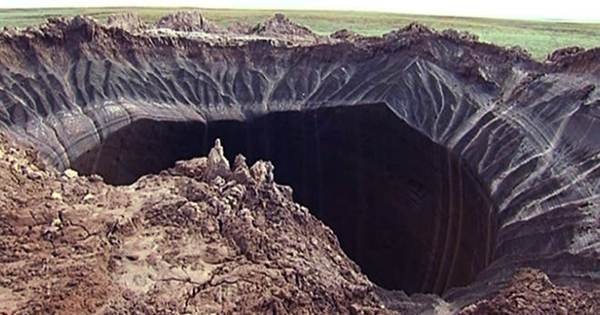It’s 2021, so “Mysterious Giant Crater Opened in Siberia” is a quick node and more than “yes, I hope so”, that’s why you probably discovered it when it was discovered earlier this year. The crew of the film first saw the hole as they climbed the Yamal Peninsula – a region known to locals as the “end of the world” by helicopter. Whatever the eruption it was, it threw rocks, ice and soil scattered hundreds of meters across the landscape.
This is not the first time in Siberia. In fact, it has taken the total number of these holes to 17. As you would expect, an explosion, some of which was heard 100 kilometers (62 miles) away, left a huge mound on the ground. When it happens in a place called “the end of the world” you probably think of it a little over the nose, even for 2021.
Although no one was harmed by them, as they occur far away from anyone living near them, it could be a sign of permafrost melting after rising temperatures in the region. When they first appeared in 2014, it was not clear what caused them, although everything from meteors to aliens was proposed by both scientists and cranks. We now know that they were probably caused by the formation of gas beneath the surface.
Satellite analysis conducted earlier this year found that craters occurred everywhere where there was Mb (or pingos, a small hill with an ice core). At about -6- themselves meters (.5.5-20 feet) high, the bees grow very fast before the eruption, much faster than the surrounding pingos, which tend to rise and fall with the seasons and tend to collapse on their own instead of exploding.
Another study that took samples from the bottom of the grooves concluded that the cracks in the cracks probably occurred after methane formation below the surface. The study authors wrote, “The accumulated methane in the clay-sand interface puts pressure on the table ground icy region, resulting in the development of the mound-precursor.”“The pressure in this mound– a gas leaking crater exploded as the predecessors overstepped the limits of the overlying substrate.”
As permafrost decreases with increasing temperature, bacteria and other germs also melt and immediately start working by pumping methane. When the gas above the ground is trapped, it creates these high-pressure mounds, which eventually flow to their top. As temperatures rise in the region, we see more of this happening, which is bad news for methane greenhouse gases and therefore leading to further warming.
Sue Natali of the Woodwell Climate Research Center in Woods Hole, Massachusetts told BBC Future, “The Craters are a wonderful indicator of what’s happening more broadly in the Arctic.”When you look at the changes that are happening across this landscape, some are happening slowly and others are happening suddenly. Very few are happening explosively, but attention has been drawn to how all of these changes are contributing to atmospheric greenhouse gases.”
















